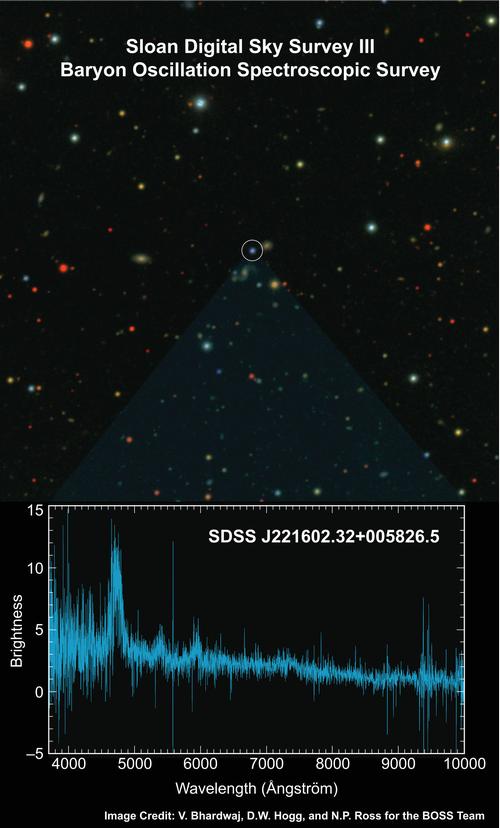Baryon oscillations began when pressure waves travelled through the early universe. An ambitious attempt to trace the history of the universe, called the Baryon Oscillation Spectroscopic Survey (BOSS), has seen first light. BOSS, a part of the Sloan Digital Sky Survey III (SDSS-III), took its first astronomical data on the night of September 14th.
That night, astronomers used the Sloan Foundation 2.5-meter telescope at Apache Point Observatory in New Mexico to measure the spectra of a thousand galaxies and quasars, thus starting a quest to eventually collect spectra for 1.4 million galaxies and 160,000 quasars by 2014.

One of the first light spectra taken by the Baryon Oscillation Spectroscopic Survey (BOSS) shows the targeted blue quasar, highlighted in the image of the sky above, which are thought to be supermassive black holes in distant galaxies. At the bottom is shown the BOSS spectrum of the object which allows astronomers to measure the "redshift", or distance to this object. BOSS plans to collect millions of such spectra and use their distances to map the geometry of the Universe. Figure credit: D. Hogg, V. Bhardwaj and N. Ross
The BOSS spectrographs will work with more than two thousand large metal plates that are placed at the focal plane of the telescope; these plates are drilled with the precise locations of nearly two million objects across the northern sky. Optical fibers plugged into a thousand tiny holes in each of these "plug plates" carry the light from each observed galaxy or quasar to BOSS's new spectrographs.
"The data from BOSS will be the best ever obtained on the large-scale structure of the universe," said David Schlegel of the U.S. Department of Energy's Lawrence Berkeley National Laboratory (Berkeley Lab), the Principal Investigator of BOSS.
BOSS uses the same telescope as the original Sloan Digital Sky Survey, but equipped with new, specially-built spectrographs to measure the spectra.
"The new spectrographs are much more efficient in infrared light," explained Natalie Roe of Berkeley Lab, the Instrument Scientist for BOSS. "The light emitted by distant galaxies arrives at Earth as infrared light, so these improved spectrographs are able to look much farther back in time."
"In the early universe, these waves were moving at half the speed of light, but when the universe was only a few hundred thousand years old, the universe cooled enough to halt the waves, leaving a signature 500 million light years in length," said Nikhil Padmanabhan, a BOSS researcher from Yale University.
"We can see these frozen waves in the distribution of galaxies today," said Daniel Eisenstein of the University of Arizona, the Director of the SDSS-III. "By measuring the length of the baryon oscillations, we can determine how dark energy has affected the expansion history of the universe. That in turn helps us figure out what dark energy could be."
"Studying baryon oscillations is an exciting method for measuring dark energy in a way that's complementary to techniques in supernova cosmology," said Kyle Dawson of the University of Utah, who is leading the commissioning of BOSS. "BOSS's galaxy measurements will be a revolutionary dataset that will provide rich insights into the Universe," added Martin White of Berkeley Lab, BOSS's survey scientist.
The first public data release from SDSS-III is planned for December 2010 under the watchful eye of Mike Blanton at the New York University. "Making high-quality astronomical data available to all on the Web continues to revolutionize astronomical science and education, by taking advantage of the talents of not just our team, but of all astronomers and also the general public." Mike explains that the original SDSS data has already been used by others in thousands of research papers.
"This continues the legacy of the SDSS, one of the most productive astronomical surveys ever undertaken," said Jim Gunn of Princeton University, who will be awarded this month the National Medal for Science from President Obama for his pioneering work with the original SDSS.
"The leadership of this next generation of the SDSS has passed to the young scientists who did most of the hard work in SDSS I and II, and they have done a wonderful job, quickly and well. Bravo!"
Read more about the Sloan Digital Sky Survey at http://www.sdss.org/




Comments